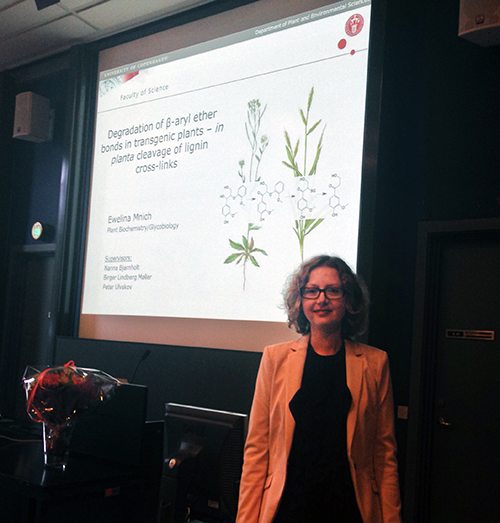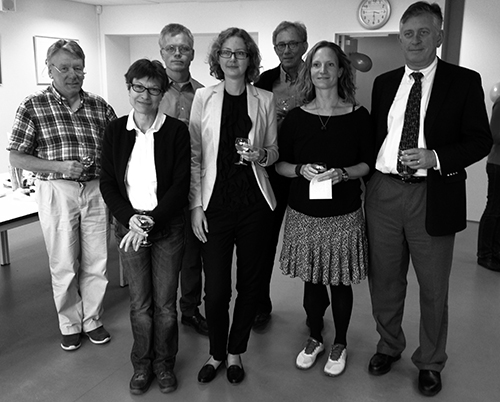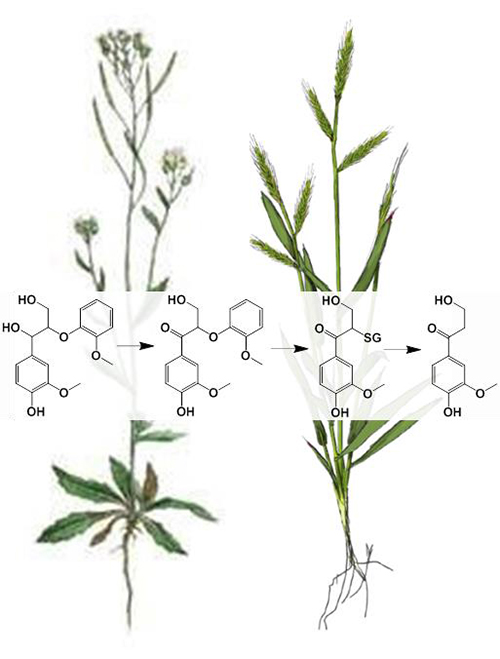Congratulations Ewelina Mnich
Today Ewelina Mnich was awarded her PhD degree for the thesis entitled: Degradation of β-aryl ether bonds in transgenic plants - in planta cleavage of lignin cross-links

Ewelina Mnich ready to defend

Polish-Danish celebration

Peter Ulvskov, Fabienne Guillon, Claus Felby, Ewelina Mnich, Birger L Møller, Nanna Bjarnholt and Clint Chapple

Summary of Ewelina's work
Lignin is one of the main building blocks of the plant cell wall. It tethers the cell wall by cross-linking with polysaccharides conferring mechanical strength to plants, aiding water transport and providing a mechanical barrier against pathogens. It is generated by the polymerization of the monolignols coniferyl alcohol, p-coumaryl alcohol and sinapyl alcohol which during radical-mediated oxidative coupling bind together forming different linkage types. Lignin is the main obstacle in biofuel production as it forms a mechanical barrier limiting accessibility for polysaccharide hydrolyzing enzymes. Compared to other plants grass cell walls contain elevated amount of ferulates which play a crucial role in cross-linking of polysaccharides and lignin. In addition ferulates are believed to be nucleation cites for the lignification. The bacterium Sphingomonas paucimobilis SYK6 has developed an enzyme system to degrade lignin. An important step in this degradation is cleavage of the most abundant lignin linkage type, β-aryl ether. It is cleaved in a three step reaction catalyzed by a dehydrogenase, a glutathione S-transferase and a glutathione lyase. Due to the nature of the enzymatic reactions, the final product is unable to form new lignin bonds at the carbon originally holding the ether bond. Therefore lignin with decreased content of ether bonds caused by the S. paucimobilis pathway would presumably be less branched, and such modifications will improve the yield from saccharification of the cell wall. The aim of the study was to alter lignin structure by expression in plants of the enzymes from S. paucimobilis involved in ether bond degradation (LigDFG). Arabidopsis thaliana and Brachypodium distachyon transgenic lines were generated and characterized with respect to lignin structure and cell wall polysaccharide extractability. Structural changes in lignin detected by 2D HSQC NMR analysis of transgenic Arabidopsis stems correlated with a slight increase in the saccharification yield. An increase in oxidized guaiacyl and syringyl units resulting from the action of LigDFG was observed. Presumably, this made the lignin less branched and allowed higher accessibility to the cell wall polysaccharides. In addition, 2D HSQC NMR and phenolic profiling provided new information on the substrate specificity of LigDFG enzymes. For grasses it was shown that the ferulate-monolignol ether bond can also be degraded by LigDFG, which can presumably cause loosening of the lignin-ferulate-polysaccharide matrix. In a xylanase hydrolysis of Brachypodium transgenic stems, the release of arabinose and xylose was increased compared to wild type. The data presented demonstrate that introduction of lignin degrading enzymes from microbial sources can affect the cell wall structure and influence the polysaccharide extractability which is essential for improving and decreasing the cost of biofuel production.
Principal Academic advisor:
Nanna Bjarnholt
Co-supervisor:
Birger Lindberg Møller
Peter Ulvskov
Jesper Harholt
Opponents:
Fabienne Guillon, INRA, France
Clint Chapple, Purdue University, USA
